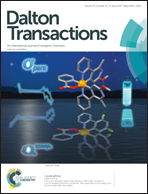Light-responsive three-dimensional microstructures composed of azobenzene-based palladium complexes
Abstract
We describe not only fleeting assembly of photoisomerizable azobenzene-based palladium complexes into microstructured crystalline architectures but also their light-responsive functions. A transformation in the crystalline morphology from two-dimensional (2D) parallelogram-like sheets to three-dimensional (3D) cuboid- or rhombus-like structures was achieved by changing the solvent from tetrahydrofuran (THF) to acetone and N,N-dimethylformamide (DMF). The sizes of the structures, ranging from a few hundred nanometers to several hundred micrometers, were also modified by varying the complex concentration. In stark contrast to the very stable 2D sheets in the THF–H2O suspensions, exposure of 3D structures in polar DMF–H2O suspensions to ultraviolet (UV) light led to fast disassembly of the structures into isolated metal complexes and further dissociation of free azobenzene ligands from the complexes. In acetone–H2O suspensions, interestingly, disassembly of 3D cuboid-like structures into isolated complex components occurred upon exposure to UV light without further dissociation of azobenzene ligands from the palladium complexes. Considering the photoisomerization ability of the azobenzene-based palladium complex in common organic solvents, the π-stacking interactions that support 3D structures are likely to be sufficiently weak that they might be broken by the UV-induced trans-to-cis isomerization in more polar solvent mixtures. As a consequence, disassembly proceeded under UV light irradiation. Moreover, the effect of solvent polarity on the UV-assisted dissociation (in DMF–H2O) may be associated with the coordination ability of solvent molecules with the metal center.


 Please wait while we load your content...
Please wait while we load your content...